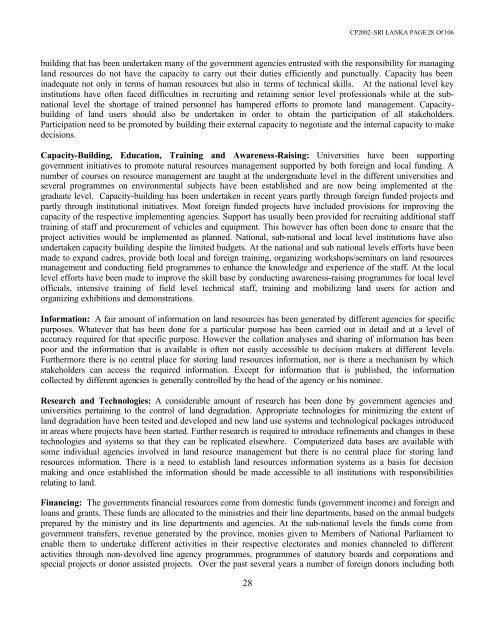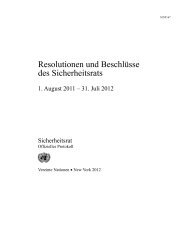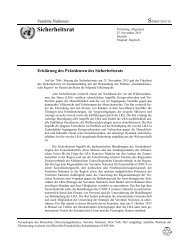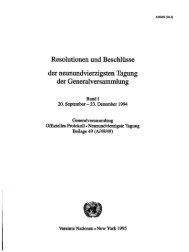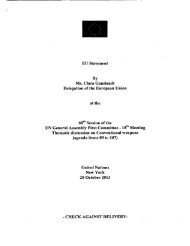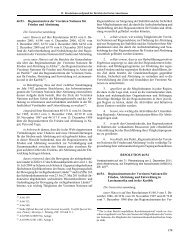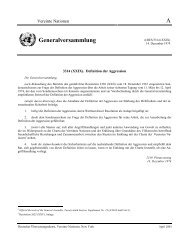SRI LANKA COUNTRY PROFILE
SRI LANKA COUNTRY PROFILE
SRI LANKA COUNTRY PROFILE
You also want an ePaper? Increase the reach of your titles
YUMPU automatically turns print PDFs into web optimized ePapers that Google loves.
28<br />
CP2002-<strong>SRI</strong> <strong>LANKA</strong> PAGE 28 Of 106<br />
building that has been undertaken many of the government agencies entrusted with the responsibility for managing<br />
land resources do not have the capacity to carry out their duties efficiently and punctually. Capacity has been<br />
inadequate not only in terms of human resources but also in terms of technical skills. At the national level key<br />
institutions have often faced difficulties in recruiting and retaining senior level professionals while at the subnational<br />
level the shortage of trained personnel has hampered efforts to promote land management. Capacitybuilding<br />
of land users should also be undertaken in order to obtain the participation of all stakeholders.<br />
Participation need to be promoted by building their external capacity to negotiate and the internal capacity to make<br />
decisions.<br />
Capacity-Building, Education, Training and Awareness-Raising: Universities have been supporting<br />
government initiatives to promote natural resources management supported by both foreign and local funding. A<br />
number of courses on resource management are taught at the undergraduate level in the different universities and<br />
several programmes on environmental subjects have been established and are now being implemented at the<br />
graduate level. Capacity-building has been undertaken in recent years partly through foreign funded projects and<br />
partly through institutional initiatives. Most foreign funded projects have included provisions for improving the<br />
capacity of the respective implementing agencies. Support has usually been provided for recruiting additional staff<br />
training of staff and procurement of vehicles and equipment. This however has often been done to ensure that the<br />
project activities would be implemented as planned. National, sub-national and local level institutions have also<br />
undertaken capacity building despite the limited budgets. At the national and sub national levels efforts have been<br />
made to expand cadres, provide both local and foreign training, organizing workshops/seminars on land resources<br />
management and conducting field programmes to enhance the knowledge and experience of the staff. At the local<br />
level efforts have been made to improve the skill base by conducting awareness-raising programmes for local level<br />
officials, intensive training of field level technical staff, training and mobilizing land users for action and<br />
organizing exhibitions and demonstrations.<br />
Information: A fair amount of information on land resources has been generated by different agencies for specific<br />
purposes. Whatever that has been done for a particular purpose has been carried out in detail and at a level of<br />
accuracy required for that specific purpose. However the collation analyses and sharing of information has been<br />
poor and the information that is available is often not easily accessible to decision makers at different levels.<br />
Furthermore there is no central place for storing land resources information, nor is there a mechanism by which<br />
stakeholders can access the required information. Except for information that is published, the information<br />
collected by different agencies is generally controlled by the head of the agency or his nominee.<br />
Research and Technologies: A considerable amount of research has been done by government agencies and<br />
universities pertaining to the control of land degradation. Appropriate technologies for minimizing the extent of<br />
land degradation have been tested and developed and new land use systems and technological packages introduced<br />
in areas where projects have been started. Further research is required to introduce refinements and changes in these<br />
technologies and systems so that they can be replicated elsewhere. Computerized data bases are available with<br />
some individual agencies involved in land resource management but there is no central place for storing land<br />
resources information. There is a need to establish land resources information systems as a basis for decision<br />
making and once established the information should be made accessible to all institutions with responsibilities<br />
relating to land.<br />
Financing: The governments financial resources come from domestic funds (government income) and foreign and<br />
loans and grants. These funds are allocated to the ministries and their line departments, based on the annual budgets<br />
prepared by the ministry and its line departments and agencies. At the sub-national levels the funds come from<br />
government transfers, revenue generated by the province, monies given to Members of National Parliament to<br />
enable them to undertake different activities in their respective electorates and monies channeled to different<br />
activities through non-devolved line agency programmes, programmes of statutory boards and corporations and<br />
special projects or donor assisted projects. Over the past several years a number of foreign donors including both


